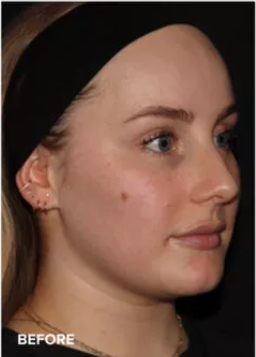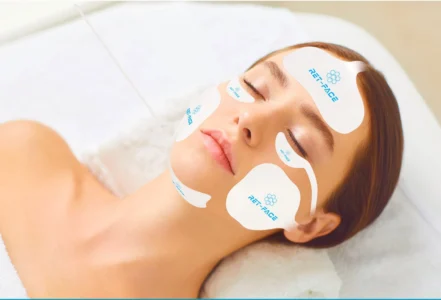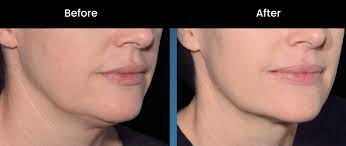What is EMS for the Face?
While EMS (Electrical Muscle Stimulation) is traditionally used for muscle recovery, newer cosmetic treatments like Emface, which combines electrical stimulation with radiofrequency, are gaining attention in dermatology for facial anti-aging.
EMS for the face uses weak electrical currents to stimulate the facial muscles. This causes the muscles to involuntarily contract and is intended to be a “passive workout” for the face.
The goal is to lift and tone the facial muscles, which proponents believe can create a more sculpted, lifted, and youthful appearance.
While microcurrent facials use a very low level of electrical current, newer treatments such as Emface use a more intense form of electrical stimulation called HIFES (High-Intensity Facial Electrical Stimulation) to deliver stronger muscle contractions.
A Dermatologist’s Perspective on Emface
As a modern and professionally administered version of facial electrical stimulation, Emface uses a combined approach to address signs of aging.
Dual-technology treatment
Emface combines HIFES (electrical muscle stimulation) with radiofrequency (RF) technology.
How it Works:
- HIFES: Contracts and tones the facial muscles, such as those in the cheeks and forehead, to lift the facial tissue.
- Radiofrequency: Heats the skin to stimulate the production of new collagen and elastin, the proteins that keep skin firm and plump.
Benefits
Clinical studies have shown that high-frequency EMS treatments can improve skin elasticity, reduce wrinkles, and lessen facial sagging.
What to Expect
The treatment uses adhesive pads on the face and takes about 20 minutes with no downtime. You will feel warmth from the RF and the involuntary twitching of your facial muscles from the HIFES.
Recommended Schedule
A full treatment course typically involves four sessions, spaced about a week or two apart, with maintenance sessions once or twice a year.
Professional vs. At-Home Devices
- Strength: Professional devices are much more powerful, which can lead to more pronounced results.
- Customization: A dermatologist can tailor the treatment to your specific needs and may combine it with other therapies.
- Expertise: A dermatologist ensures the procedure is done correctly and safely. They can determine if you are a good candidate or if you have contraindications, such as having a pacemaker or metal in your face.
- Results: At-home devices require consistent use over a longer period to achieve less dramatic results than professional, in-office treatments.
Things to Consider
- Effectiveness: While research is promising for combined-technology treatments like Emface, the long-term effectiveness and safety of simpler, single-modality facial EMS are still being studied.
- Cost: Professional EMS treatments are more expensive than at-home devices but may offer more significant and longer-lasting results.
- Candidacy: People with certain medical conditions, like epilepsy or heart issues, should avoid EMS treatments. It is essential to consult a dermatologist to ensure you are a safe candidate for the procedure.
How it Works
Preparation
Your clinician begins by cleansing your face to ensure the adhesive applicators stick properly. A grounding pad is also placed on your back for safety during the electrical stimulation.
RF energy heats the skin
The applicators emit synchronized RF energy, which delivers controlled heat to the deep dermal layers of your skin. This heat stimulates your body to naturally produce new collagen and elastin fibers, which improves skin firmness and elasticity over time.
HIFES tones the muscles
At the same time, the applicators send HIFES electromagnetic pulses that cause involuntary contractions in your facial muscles. This strengthens and tones the underlying muscle structure, leading to a visible lift and more defined facial contours
No downtime recovery
After the 20-minute session, the applicators are removed, and you can immediately resume your daily activities. Some people experience mild redness or a warm sensation, but these effects typically subside within a few hours.



